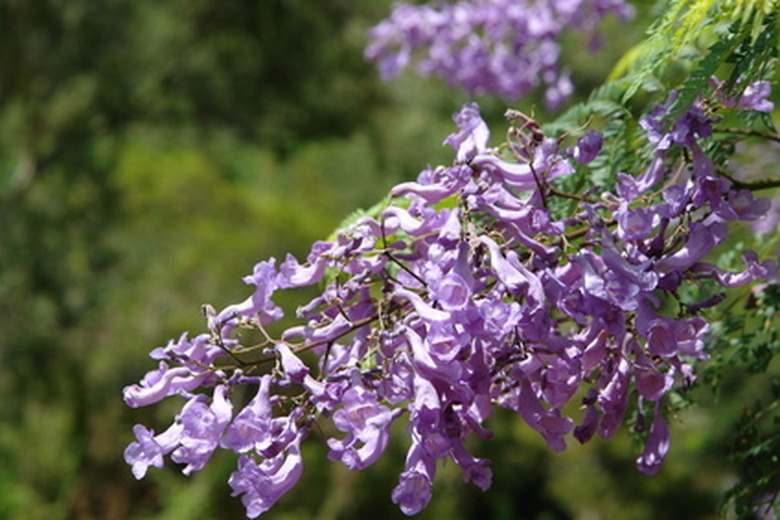How To Grow Jacaranda Trees In Texas
Jacaranda (Jacaranda acutifolia) trees are semi-evergreen-to deciduous tropical trees, which make them perfect ornamental trees for a Texas garden. Jacaranda trees are visually striking; they produce masses of bright, blue-lavender, trumpet-shaped flowers that bloom in 8-inch-long, pyramid-like clusters. They love full sun, and need regular watering.
Step 1
Dig a planting hole for the jacaranda tree that is three times the diameter of its growing container and approximately twice its depth. Make sure the location you choose for planting the jacaranda tree will offer it protection from the wind. This is particularly important if you live in the three windiest regions of Texas; the mountain passes of the Trans-Pecos area, the Panhandle region or in or around Galveston.
Step 2
Amend the soil you removed from the planting hole. Use a 5-gallon bucket full of compost, aged manure, rotted leaves or any other like material and mix it into the soil thoroughly . If you live in North Texas, which is known for having heavy, clay soil, mix into the soil a 3-inch layer of expanded shale over the planting area, as recommended by Texas A&M University.
- Jacaranda (Jacaranda acutifolia) trees are semi-evergreen-to deciduous tropical trees, which make them perfect ornamental trees for a Texas garden.
- If you live in North Texas, which is known for having heavy, clay soil, mix into the soil a 3-inch layer of expanded shale over the planting area, as recommended by Texas A&M University.
Step 3
Remove the jacaranda tree from its planting container. Lay the container horizontal on the ground. Use a hammer, trowel or a sturdy block of wood and tap along the edge of the container until it starts to loosen. Then, slide the container off the root ball.
Step 4
Set the jacaranda tree into the planting hole. Pour water into the planting hole until it's about half-full. After the water has drained away, make sure the jacaranda tree is sitting vertical in the planting hole. Fill up the remainder of the planting hole with the soil and organic amendment.
- Remove the jacaranda tree from its planting container.
- Set the jacaranda tree into the planting hole.
Step 5
Create a 2- to 3-inch-high circular berm of dirt approximately 20 to 24 inches in diameter around the jacaranda tree. The berm of dirt will help when watering to allow water to accumulate so it can soak down to reach the roots. This is especially useful if you live in southwest Texas, where it's quite arid and dry.
Step 6
Water the jacaranda tree during dry periods (when there is no rainfall). Jacaranda trees have many surface roots, so make sure you provide heavy, frequent watering. This is best done at bloom time and continued through summer, tapering off in late summer to prevent new growth which can be damaged by winter temperatures.
Tip
Jacaranda trees are known for having problems with breakage, to offer the jacaranda tree support as it grows, insert a 2-inch by 2-inch planting stake 12 to 15 inches into the ground near the jacaranda tree. Then use heavy gauge guy wire or heavy duty gardeners' twine and tie the jacaranda tree to the planting stake. (Length of planting stake depends on the size of jacaranda tree you are planting.)
Things Needed
- Jacaranda tree
- Shovel
- Soil amendment
- Shale
- Hammer or trowel
- 2-inch by 2-inch planting state
